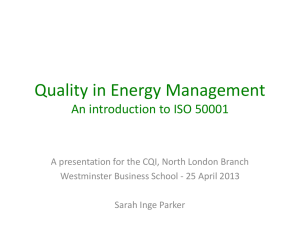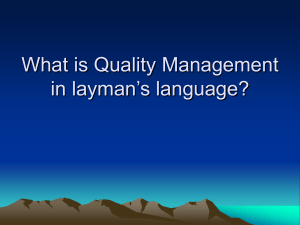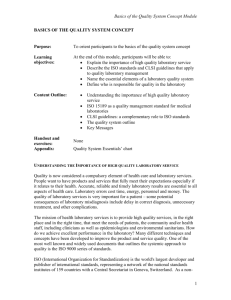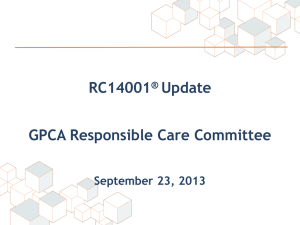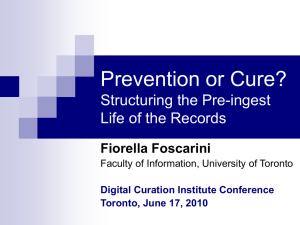4.3 Basics of Quality System Concept
advertisement
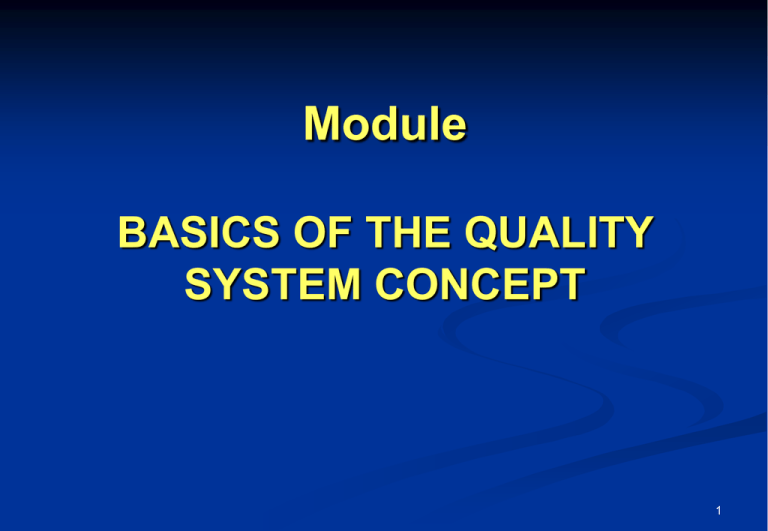
Module BASICS OF THE QUALITY SYSTEM CONCEPT 1 Content Overview • Understanding importance of high quality • • • laboratory service ISO 15189 as a quality management standard for medical laboratories CLSI guidelines: a complementary role to ISO standards The quality system outline 2 Importance of High Quality Laboratory Service Accurate, reliable and timely laboratory results are essential to all aspects of health care 3 Mission of Health Laboratory Services • • • Provide high quality services: in the right place in the right time in respect of the needs of • patients • community • health staff • clinicians • epidemiologists • environmental sanitarians 4 How Do We Achieve Excellent Performance in the Laboratory? Importance of Quality Systems • • Different techniques and concepts have been developed to improve product or service quality ISO 9000 series of standards • widely used • outlines the systemic approach to quality 5 International Organization for Standardization (ISO) • Non-governmental organization established in • • 1947 Worldwide federation of national standards bodies Develops voluntary consensus standards (and other types of document) 6 ISO 9000 Family • Guidance for quality in manufacturing and • service industries Has broad applicability, many kinds of organizations can use ISO 9001:2000, Quality management system – Requirements 7 ISO Documents - Laboratory ISO 15189:2007, Medical laboratories - Particular requirements to quality and competence • Valuable compilation of statements to assist laboratory specialists in understanding and implementing quality management systems • Has become the international foundation for medical laboratory accreditation 8 ISO 15189:2007: Content Management Requirement • • • • • • • • • • • • • • • Organization Quality management system Document control Contract review Referral laboratories Supplier review Advisory services Complaint resolution Identification and control of nonconformities Corrective actions Preventive actions Continual Improvement Quality and technical records Internal audits Management review Technical Requirements • • • • • • • • Personnel authorities and responsibilities Accommodation and environmental conditions Laboratory equipment Pre-examination procedures Examination procedures Assuring quality of examination procedures Post-Examination procedures Reporting of results Annexes 9 National Committee for Clinical Laboratory Standards (NCCLS) • A committed forum for laboratory improvement through consensus, guidelines, and standardization. International in scope and participation • • in 2005 • • World Health Organization Collaborating Centre Secretariat – ISO Technical Committee 212 Ten area committees addressing the full range of laboratory activities. 10 CLSI Quality Standards Guideline No. Title HS1-A2 A Quality Management System Model for Health Care GP 26-A3 Describes quality system model, 12 essentials Applicable to all health care systems, Applies quality design consistent with ISO 9000 series Application of Quality Management System Model for Laboratory Services • Laboratory application document for quality system • Describes path of workflow • Assists lab in improving processes • Relates to HS1-A 11 ISO vs. CLSI • Complimentary not conflicting roles • ISO provides broad standard requirements • CLSI provides detailed best practices, standards and practical guidance for implementation 12 Quality System Organizational structure, resources, processes and procedures needed to implement quality management (ISO, CLSI) 13 Quality System Essentials Set of coordinated activities that function as building blocks for quality management 14 Application of a Quality System Approach Helps • Ensure quality of overall process • Detect and reduce errors, • Improve consistency within and between • • laboratories Contain costs Ensure customer satisfaction 15 Who Is Responsible for Quality in the Laboratory? EVERYONE! 16 Key Messages • • • • • Accurate, reliable and timely laboratory results are essential to all aspects of health care. The ISO 15189 standard is a valuable tool for development of effective quality management in a laboratory The CLSI guidelines are tied very closely to the ISO standards and are a way to “translate” ISO standards into laboratory language The rationale for applying a quality system approach is to ensure quality of overall process, detect and reduce errors, improve consistency within and between laboratories, contain costs, ensure customer satisfaction. Everyone in the laboratory is responsible for quality 17




